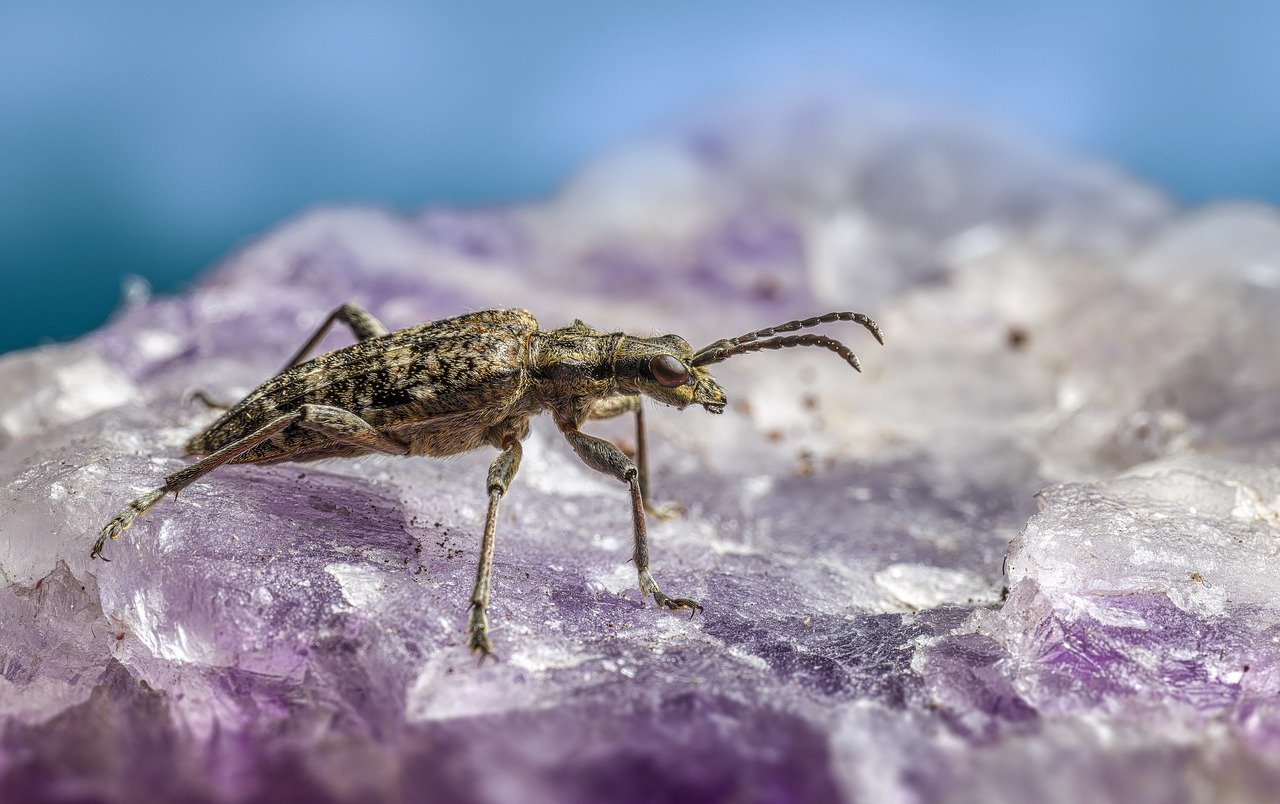The Black-spotted Longhorn Beetle (Rhagium mordax) is a notable species of beetle belonging to the Cerambycidae family, known for its distinctive appearance and behaviors. This beetle is native to various parts of Europe and North America and is recognized for its role in the ecosystem as a decomposer.
Physical Description
- Size: The Black-spotted Longhorn Beetle is a medium-sized beetle, typically measuring between 10 to 16 mm (0.4 to 0.6 inches) in length.
- Coloration: The beetle’s coloration is primarily a mix of black and white or pale yellow. Its elytra (wing covers) are often mottled with black spots or patches, which provide a striking appearance.
- Antennas: One of the most distinctive features of this species is its long, thread-like antennae, which are about 1.5 to 2 times the length of its body. These antennae are characteristic of longhorn beetles and are used for sensing the environment.
- Body Shape: The body is elongated and cylindrical, with a somewhat flattened appearance. The legs are long and slender, adapted for movement through its habitat.
Distribution and Habitat
- Range: Rhagium mordax is found across Europe and parts of North America. It inhabits various forested environments, including deciduous and mixed woodlands.
- Habitat Preferences: It prefers habitats with abundant decaying wood, which provides essential resources for its larval stage. The beetle is often found in old or decaying trees, fallen logs, and stumps.
Behavior and Diet
- Larval Stage: The larvae of the Black-spotted Longhorn Beetle feed on decaying wood. They are wood-borers, meaning they create tunnels within the wood, which helps in breaking down and recycling the organic material. This behavior is crucial for nutrient cycling in forest ecosystems.
- Adult Diet: Adult beetles primarily feed on nectar and pollen from various flowers. They are also known to visit sap flows on trees.
Reproduction and Lifecycle
- Mating: The mating process usually occurs on the surface of logs or trees where the beetles are active. After mating, the female lays eggs in crevices or directly into decaying wood.
- Development: The eggs hatch into larvae, which spend several months to a year developing within the wood. They go through several larval stages before pupating.
- Pupation: Pupation occurs within the wood or in the soil surrounding the decaying wood. After completing the pupal stage, the adult beetles emerge from the wood to continue the life cycle.
Ecological Role
- Decomposition: The Black-spotted Longhorn Beetle plays a significant role in the decomposition of dead wood. By feeding on and tunneling through decaying wood, the larvae contribute to the breakdown of this material and the recycling of nutrients back into the ecosystem.
- Pollination: As adults, these beetles contribute to the pollination of flowers while feeding on nectar and pollen.
Conservation Status
The Black-spotted Longhorn Beetle is not currently listed as threatened or endangered. It is considered to have a stable population across its range. However, like many species, it can be affected by habitat destruction, particularly the loss of old and decaying wood habitats due to logging and land management practices.
Summary
The Black-spotted Longhorn Beetle (Rhagium mordax) is a fascinating insect with a distinctive appearance and important ecological roles. Its larval stage contributes to the decomposition of dead wood, aiding in nutrient recycling, while the adults play a part in pollination. Understanding and preserving its habitat is essential for maintaining the health of forest ecosystems and ensuring the continued presence of this unique beetle species.e in forested habitats highlights the interconnectedness of species within ecosystems and underscores the importance of biodiversity conservation efforts.
In the macro photograph, a Black-spotted Longhorn Beetle (Rhagium mordax) is depicted perched delicately atop a mineral crystal. The beetle’s intricate black spots are sharply contrasted against its pale exoskeleton, showcasing its distinct patterns and long, slender antennae. The mineral crystal beneath it, likely a clear or slightly tinted variety, provides a sparkling and textured backdrop that highlights the beetle’s delicate features. The studio setting ensures precise lighting and focus, capturing the beetle’s minute details and the reflective surfaces of the crystal with stunning clarity.
Beetles in Estonia
Estonia, with its diverse habitats ranging from forests to wetlands and meadows, hosts a variety of beetle species. Some notable beetles you might find in Estonia include:
- Stag Beetle (Lucanus cervus): One of the largest beetles in Europe, known for its impressive, stag-like mandibles. It inhabits old forests and woodlands.
- Rhinoceros Beetle (Oryctes nasicornis): Recognizable by its horn-like projection on the head, this beetle is commonly found in decaying wood.
- Ladybird Beetles (Coccinellidae): Various species of ladybirds are present, known for their bright colors and spots. They are beneficial for controlling aphid populations.
- Ground Beetles (Carabidae): This family includes many species, such as the Common Ground Beetle (Carabus nemoralis), which are often found in leaf litter and on the ground.
- Longhorn Beetles (Cerambycidae): Beetles like the Black-spotted Longhorn Beetle (Rhagium mordax) are characterized by their long antennae and can be seen on decaying wood.
- Rove Beetles (Staphylinidae): These beetles are known for their short elytra and long abdomens. They are often found under logs or in leaf litter.
- Weevils (Curculionidae): This family includes various species that often feed on plants. The Common Weevil (Sitona lineatus) is one example.
- Cockchafers (Melolontha melolontha): Also known as June beetles, they are notable for their large size and are often found in grassy areas.
Estonia’s beetle diversity reflects its rich natural environment, offering a wide array of species adapted to different ecological niches.
Views: 1322
Subscribe to the newsletter:
